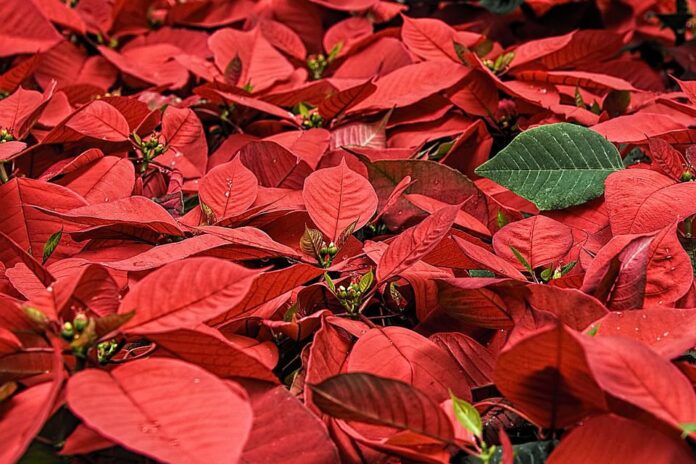By Lori Murray, Cameron County Master Gardener, Texas Superstar Specialist
What can you do with your poinsettias when the holidays are over? Fortunately, those of us who live in the Valley can save them – indoors or outdoors – to bloom next year! The attention they need is spread out over the year, so unless you have a photographic memory, cut this out and keep it handy. You will be delighted with the results!
January through March, keep the pot in strong indirect sunlight and water when the surface is dry. (You can put it on the patio so long as you don’t leave it there in cold weather.)
Fertilize weekly with half-strength houseplant fertilizer. Beginning in April, remove the bracts – the red leaves – and part of the stem. Leave three or four leaves on each remaining stem. Gradually decrease watering, allowing the plant to dry out between waterings. Indoors, be sure the plant is out of the draft from central air conditioning.
(Note: I just watered mine when I watered the rest of the pots, and I can’t see that it did any harm.)
In mid-May, cut the stems back to about four inches and repot in a larger container, watering well. Keep the plant in bright indirect sunlight. Water when the top half inch of soil is dry. Once new growth appears, begin fertilizing every two weeks with a complete fertilizer.
In early July, pinch back an inch to encourage bushiness. This is the time to begin giving the plant a systemic that will repel the white fly that will be rampant once the last of the cotton is plowed under late in summer. (White fly find poinsettias very tasty and once they attack a plant it’s usually a total loss. I lost three plants several years ago because I didn’t notice the white fly soon enough. That’s why the best defense is a systemic started early. It can be discontinued in the fall, around October.)
Pinch back again in August. The last pruning or pinch before flowering should be done in late August. Continue to water and fertilize and use the white fly deterrent.
Beginning October 1, make sure the plant has complete darkness at night. Indoors, use a dark closet or cover the plant with a dense black cloth. Outdoors, make sure the pot isn’t near a security light. If you cannot keep it from light in the nighttime, cover it with a box, This is very important because the colors of the bracts are created through photoperiodism, meaning that they require darkness (12 hours at a time for at least 5 days in a row) to change color. This darkness creates the color of the bracts. When the bracts are colored, the plant needs bright abundant indirect sunlight during the day for the brightest color.
Darkness at night is no longer required around the last week of November when you should see the tiny flower buds inside the bracts. Stop fertilizing in mid December, but continue to water. Note: If your poinsettias are attacked by white fly (as mine have been before I discovered the systemic) cover them with bridal veiling available at Walmart. I have been assured that the white fly cannot penetrate the veiling. Given consistent care, your poinsettias will last for many years. They will be a source of great pride and pleasure each Christmas season. There are even some in San Benito that are over 50 years old!
Poinsettias, like people, should follow these rules to prevent illness: Dr. Kevin Ong, Agrilife Extension plant pathologist, College Station, offers the following advice.
1. Don’t catch cold. Poinsettias are tropical plants. They will turn yellow and drop leaves if cold or in a draft.
2. Drink in moderation. Water only when the top half inch of soil is dry.
3. Control diet. Poinsettias that fill up on a fertilizer buffet will start to look peaked. Feed a poinsettia after the holidays, when everyone else is dieting , if you want to keep it alive.
Warning: Poinsettia sap, a milky white liquid, can cause an itchy rash if touched by someone with a latex allergy . If the plant is eaten, diarrhea and vomiting will probably occur, but despite this reaction, poinsettias are not poisonous. A study at Ohio State showed that a 50 pound child would have to eat 500 to 600 leaves to have side effects. Given the fact that the leaves don’t taste very good, it’s highly unlikely that kids or pets could eat that many. Still, it never hurts to be cautious.Sources:
http://today.agrilife.org/2012/1/2/11
www.helpfulgardener.com/2003/poinsettia.html
www.gardening.about.com/od/winterinthegarden/a/Poinsettia.html
www.ext.colostate.edu/pubs/garden/07412/html
www.poinsettiacare.org
Bonnie Garcia, Cameron County Gardener http://extension .illinois.edu





